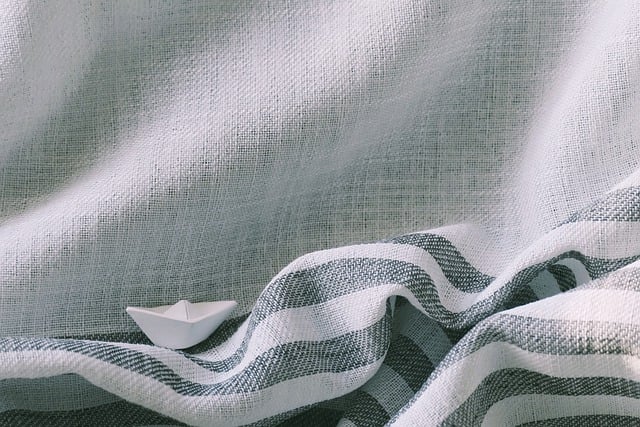In the Catholic Church, a curtain is a piece of fabric that is used to cover or separate certain areas of the church during liturgical ceremonies or services. It is often used to symbolize the separation between the sacred and the profane, or to create a sense of mystery and reverence during important moments in the church’s worship. Curtains are typically made of rich, ornate fabrics and may be adorned with religious symbols or imagery.
Table of Contents
Curtain Symbolism in Catholic Church
Have you ever noticed the curtains that hang in Catholic churches? They may seem like just another decorative element, but in reality, they hold a deeper meaning and symbolism within the church. These curtains, also known as “ciborium veils” or “tabernacle veils,” serve a specific purpose in the Catholic faith.
In the Catholic Church, the tabernacle is a sacred vessel that holds the consecrated Eucharist, which Catholics believe is the body and blood of Jesus Christ. The tabernacle is typically located on or near the altar, and it is covered by a veil or curtain. This curtain serves as a symbol of reverence and respect for the Eucharist, which Catholics believe is the real presence of Christ.
The use of curtains in the Catholic Church dates back to ancient times when curtains were used to separate the holy of holies in the Jewish temple. In the Catholic tradition, the curtain symbolizes the separation between the earthly realm and the divine presence of God. By covering the tabernacle with a veil, Catholics show their reverence for the Eucharist and acknowledge the sacredness of the presence of Christ.
The curtain also serves a practical purpose in the church. It helps to keep the Eucharist safe and protected from dust, insects, and other impurities. By covering the tabernacle with a veil, the church ensures that the Eucharist remains pure and untainted until it is distributed during the Mass.
In addition to its practical function, the curtain also serves as a visual reminder of the presence of Christ in the Eucharist. When Catholics see the curtain covering the tabernacle, they are reminded of the real presence of Christ in the Eucharist and are encouraged to approach the sacrament with reverence and devotion.
The curtain in the Catholic Church is often made of richly embroidered fabric and adorned with symbols and images that reflect the sacredness of the Eucharist. Some curtains feature images of the Lamb of God, the cross, or other religious symbols that remind Catholics of the sacrifice of Christ on the cross and the gift of the Eucharist.
In some churches, the curtain is changed according to the liturgical season or feast day. For example, during the season of Lent, the curtain may be purple to symbolize penance and preparation for Easter. During the Christmas season, the curtain may be white or gold to symbolize the joy and celebration of Christ’s birth.
Overall, the curtain in the Catholic Church serves as a powerful symbol of reverence, protection, and reminder of the real presence of Christ in the Eucharist. It is a visual representation of the sacredness of the Eucharist and a reminder to Catholics of the central role that the Eucharist plays in their faith.
Next time you visit a Catholic church, take a moment to notice the curtain covering the tabernacle. Reflect on its symbolism and significance in the Catholic faith, and consider the reverence and respect that it represents for the real presence of Christ in the Eucharist.
History of Curtains in Catholic Church
Have you ever noticed the beautiful curtains that adorn the altars in Catholic churches? These curtains, known as “Curtain” in the Catholic Church, have a long history and hold significant symbolism within the church. Let’s take a closer look at the history of curtains in the Catholic Church and their importance in religious ceremonies.
Curtains have been used in religious ceremonies for centuries, dating back to ancient times. In the Catholic Church, curtains are often used to separate the sanctuary from the rest of the church. This separation serves to create a sense of reverence and holiness, as the sanctuary is considered a sacred space where the Eucharist is celebrated.
The use of curtains in the Catholic Church can be traced back to the early days of Christianity. In the early Christian church, curtains were used to divide the sanctuary from the congregation during Mass. This practice was carried over from the Jewish tradition, where curtains were used to separate the Holy of Holies in the temple.
Over time, the use of curtains in the Catholic Church evolved, with more elaborate and ornate curtains being used to adorn the altars. These curtains were often made of rich fabrics such as silk or velvet and were embellished with intricate embroidery and designs. The use of curtains in the Catholic Church became a symbol of the church’s wealth and power, as only the most affluent churches could afford such luxurious decorations.
In addition to their decorative function, curtains in the Catholic Church also serve a practical purpose. They are often used to conceal the tabernacle, where the Eucharist is kept, from view when it is not being used in a ceremony. This helps to maintain the sanctity of the Eucharist and protect it from any potential desecration.
Curtains are also used during certain religious ceremonies, such as the Easter Vigil, to symbolize the separation between life and death. During the Easter Vigil, the sanctuary is often draped in black curtains to represent the darkness of Good Friday and the death of Jesus. These curtains are later removed to reveal the brightly lit sanctuary, symbolizing the resurrection of Christ and the triumph of life over death.
Overall, curtains in the Catholic Church hold deep symbolic meaning and play an important role in religious ceremonies. They serve to create a sense of reverence and holiness, while also adding beauty and grandeur to the church’s decor. So next time you attend Mass, take a moment to appreciate the intricate curtains that adorn the altar and reflect on their significance in the Catholic faith.
Significance of Curtains in Catholic Church

Have you ever noticed the beautiful curtains that adorn the altars and entrances of Catholic churches? These curtains, known as “Curtain” in the Catholic Church, hold a significant meaning and play an important role in the liturgical celebrations of the Church.
Curtains have been used in religious ceremonies for centuries, symbolizing a separation between the sacred and the profane. In the Catholic Church, curtains are often used to cover the tabernacle, which holds the consecrated Eucharist, as a sign of reverence and respect for the presence of Christ in the Blessed Sacrament.
During the celebration of the Mass, the curtains are drawn back to reveal the tabernacle, symbolizing the unveiling of Christ’s presence among the faithful. This act serves as a reminder of the mystery and wonder of the Eucharist, and invites the congregation to enter into a deeper sense of reverence and awe.
In addition to covering the tabernacle, curtains are also used to adorn the entrances of the church, creating a sense of anticipation and reverence as the faithful enter into the sacred space. The act of passing through the curtains serves as a physical and spiritual reminder of the transition from the secular world into the sacred realm of the church.
Curtains are often made of rich fabrics and adorned with intricate designs, reflecting the beauty and majesty of the liturgical celebrations they accompany. The colors and patterns of the curtains are often chosen to complement the liturgical season or feast day, adding to the overall sense of reverence and celebration.
The use of curtains in the Catholic Church is not only a visual reminder of the sacredness of the Eucharist and the liturgical celebrations, but also serves as a practical tool for creating a sense of mystery and awe among the faithful. The act of drawing back the curtains to reveal the tabernacle or the altar is a powerful symbol of the unveiling of Christ’s presence among us, inviting us to enter into a deeper relationship with Him.
As we reflect on the significance of curtains in the Catholic Church, we are reminded of the beauty and mystery of the Eucharist, and the importance of approaching the liturgical celebrations with reverence and awe. The use of curtains serves as a visual and symbolic reminder of the sacredness of the Mass and the presence of Christ among us, inviting us to enter into a deeper sense of worship and adoration.
So next time you attend Mass, take a moment to appreciate the beauty and significance of the curtains that adorn the altars and entrances of the church. Allow yourself to be drawn into the mystery and wonder of the Eucharist, and let the curtains serve as a reminder of the sacredness of the liturgical celebrations in the Catholic Church.
Rituals Involving Curtains in Catholic Church
Have you ever attended a Catholic Church service and noticed a curtain hanging behind the altar? You may have wondered what its significance is in the context of the church’s rituals. In the Catholic Church, the curtain holds a special place in various ceremonies and symbolizes different aspects of the faith.
During Mass, the curtain serves as a backdrop for the altar, where the priest celebrates the Eucharist. It is often made of rich fabric and adorned with intricate designs, reflecting the reverence and solemnity of the occasion. The curtain separates the sanctuary from the rest of the church, creating a sacred space where the faithful can focus on the mystery of the Eucharist.
In some churches, the curtain is drawn closed during certain parts of the Mass, such as the consecration, when the bread and wine are transformed into the body and blood of Christ. This act of veiling the altar symbolizes the hidden nature of the Eucharist, which is a central tenet of the Catholic faith. By concealing the sacred elements, the curtain invites the faithful to contemplate the mystery of Christ’s presence in the sacrament.
The use of curtains in the Catholic Church dates back to ancient times when they were used in the tabernacle of the Israelites to separate the Holy of Holies from the rest of the temple. In the Catholic tradition, the curtain symbolizes the veil that was torn in two at the moment of Christ’s death on the cross, signifying the opening of the way to God for all believers.
In addition to its role in the Mass, the curtain is also used in other rituals in the Catholic Church. For example, during the season of Lent, the curtain may be draped in purple, the liturgical color of penance and preparation. This serves as a visual reminder of the solemnity of the season and encourages the faithful to reflect on their sins and seek reconciliation with God.
In some churches, the curtain is also used during the sacrament of reconciliation, commonly known as confession. The penitent kneels behind the curtain, confessing their sins to the priest who is hidden from view. This act of confession behind the veil symbolizes the penitent’s humility and contrition before God and serves as a reminder of the privacy and confidentiality of the sacrament.
Overall, the curtain in the Catholic Church plays a significant role in various rituals and ceremonies, symbolizing the sacredness and mystery of the faith. Whether it is used to veil the altar during Mass or to create a sense of privacy during confession, the curtain serves as a visual reminder of the presence of God and the importance of reverence and humility in worship.
Next time you attend a Catholic Church service, take a moment to reflect on the significance of the curtain and how it enhances your experience of the sacred. Let it serve as a reminder of the rich traditions and rituals that have been passed down through generations, connecting you to the larger community of believers who share in the same faith and devotion.
Modern Interpretations of Curtains in Catholic Church
Have you ever noticed the curtains in a Catholic church and wondered about their significance? Curtains have been used in churches for centuries, serving both practical and symbolic purposes. In modern times, the use of curtains in Catholic churches has evolved, taking on new meanings and interpretations.
In traditional Catholic churches, curtains were often used to separate the sanctuary from the rest of the church. This division served to create a sense of reverence and awe, emphasizing the sacredness of the space where the Eucharist is celebrated. The curtains also provided a visual barrier, allowing for moments of privacy and intimacy during certain parts of the Mass.
Today, curtains in Catholic churches are still used in some places, but their meaning has shifted. Instead of being solely functional, curtains are now seen as a way to enhance the beauty and ambiance of the church. Many modern churches use curtains as decorative elements, adding color and texture to the space. These curtains are often made of luxurious fabrics and adorned with intricate designs, creating a sense of elegance and grandeur.
In addition to their aesthetic value, curtains in Catholic churches can also have symbolic significance. Some churches use curtains to symbolize the veil that separated the Holy of Holies in the Temple of Jerusalem. This veil was said to represent the separation between God and humanity, which was overcome through the sacrifice of Jesus Christ. By using curtains in their churches, some Catholics seek to evoke this sense of mystery and transcendence, reminding worshippers of the divine presence in their midst.
Another modern interpretation of curtains in Catholic churches is as a symbol of the Church’s mission to welcome all people. Just as curtains can be drawn back to reveal what lies beyond, so too can the Church open its doors to those seeking refuge and solace. The act of drawing back the curtains can be seen as a gesture of hospitality and inclusivity, inviting all to come and experience the love of God.
Overall, curtains in Catholic churches serve as a reminder of the rich history and tradition of the Church, while also allowing for new interpretations and expressions of faith. Whether used for practical purposes or as symbols of deeper spiritual truths, curtains play an important role in creating a sacred and welcoming space for worship. So next time you find yourself in a Catholic church, take a moment to appreciate the beauty and meaning of the curtains that adorn the sanctuary.
Conclusion
In the Catholic Church, a curtain is a piece of fabric that is used to cover the tabernacle, which holds the consecrated Eucharist. This curtain is typically made of a rich fabric and is used to show reverence and respect for the presence of Christ in the Eucharist. It is often opened and closed during Mass to signify the presence of Christ in the tabernacle.


